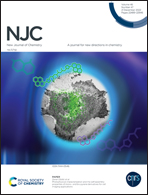Construction of targeted drug-loaded composite polysaccharide hydrogels and verification of anti-tumor effect in vitro
Abstract
Hydrogels are widely used in drug delivery systems and outperform traditional biomaterials. However, it is still a challenge to develop targeted antitumor function in hydrogels with good stability and strong mechanical properties for drug carriers. Herein, we constructed novel composite polysaccharide drug-loaded hydrogels (FA–ASA–FG/MTX) from fenugreek gum (FG) and sodium alginate conjugated with folate (FA–ASA). The interpenetrating entanglement between FG and sodium alginate could improve the mechanical properties of the composite hydrogels. Additionally, the introduction of folate endowed the hydrogels with tumor-targeting properties. The composite hydrogels were determined to have a porous structure, water absorption, good stability and a sustained release effect by the determination of load ratio, rheological characterization, swelling behavior and drug release rate. Notably, the inhibition rate of the composite hydrogels against tumors was evaluated on HepG2 cells in vitro, which confirmed the targeting function of FA–ASA–FG/MTX with dose- and time-dependent behavior. Our results indicated that the composite hydrogels were a promising targeted anti-tumor agent and represented potential advances in the field of tumor-targeted drug delivery.



 Please wait while we load your content...
Please wait while we load your content...